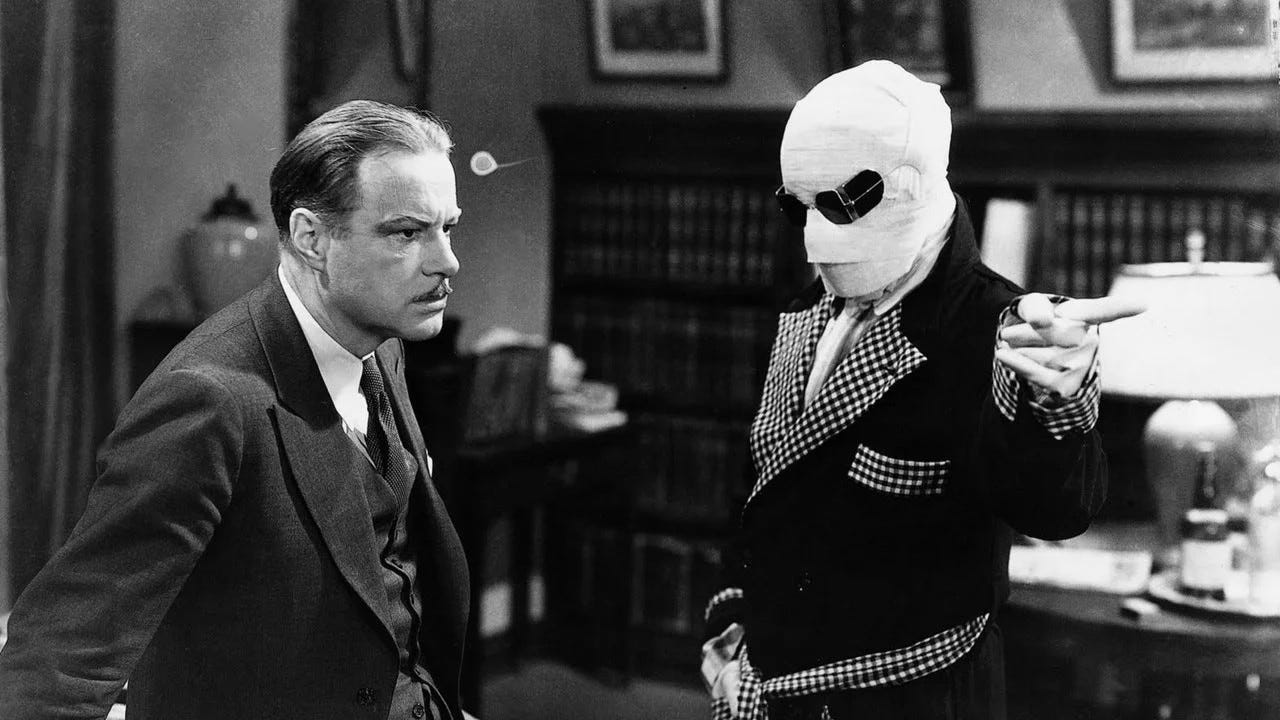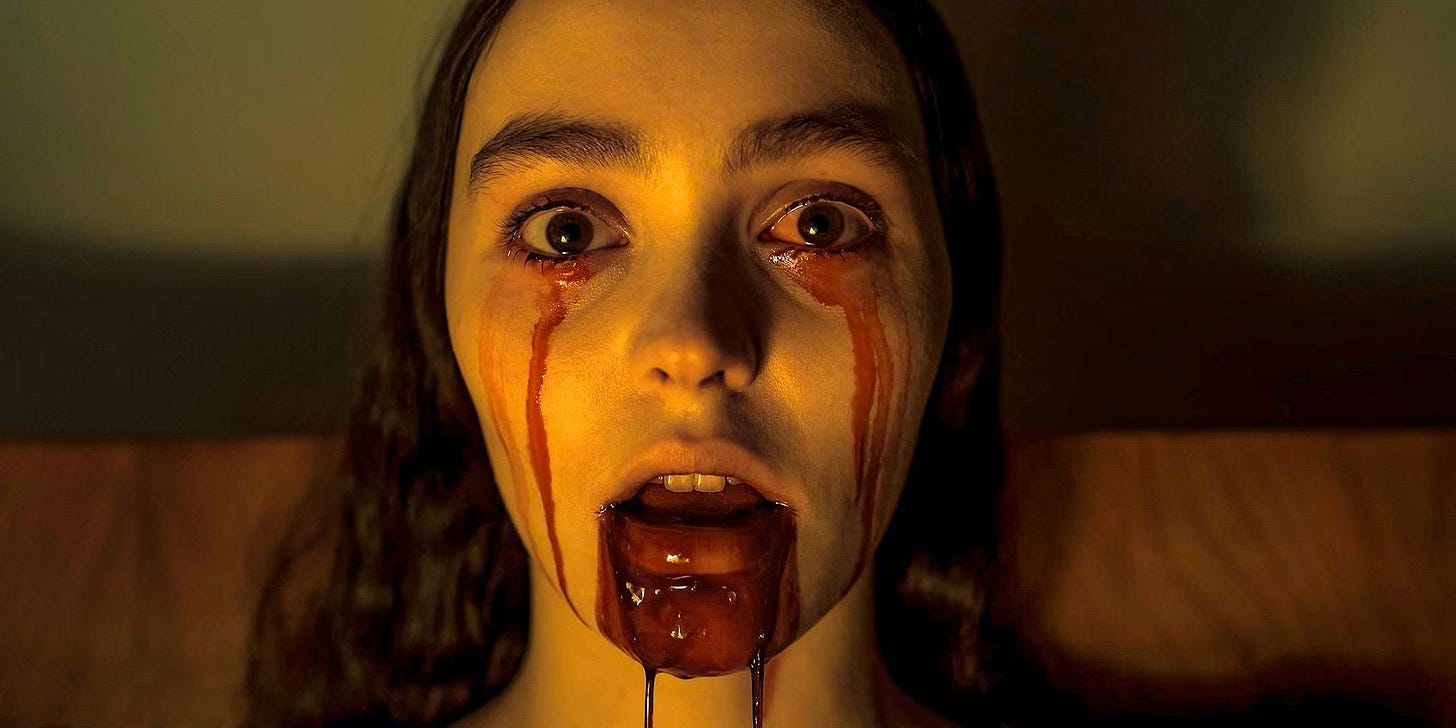Stories that Stand the Test of Time
The greatest stories work in any medium, in any era, and in any context
I recently read The Invisible Man by H.G. Wells, first published in 1897, and rewatched the classic 1933 film by the legendary James Whale to see how it translated to the screen. The original adaptation features some of my favourite practical effects, despite being over 90 years old, and Claude Rains is exceptional as the cantankerous Griffin. I also recommend the 2020 film of the same name by Australia’s own Leigh Whannell, which is a worthy reimagining that gives the iconic tale a modern twist. It’s the story of a mad scientist who discovers the secret to invisibility and how such power can be abused when it falls into the wrong hands, a familiar concept that has been explored in many different forms since.
This got me thinking about other timeless stories from the early days of cinema and how literary classics are constantly reappropriated in alternative mediums for modern audiences. One of the most popular of which – and a personal favourite of mine – is Frankenstein by Mary Shelley, also known as The Modern Prometheus, first published in 1818. A harrowing tale of ambition and alienation, Frankenstein has been adapted for the screen several times since the 1931 original, also directed by Whale, as well as for theatre, video games and even a manga rendition by the inimitable Junji Ito. The story of Victor Frankenstein and his Monster will never not be relevant, so long as we continue to play god and kill what we create.
Another great example is Bram Stoker’s Dracula, a gothic epistolary about unwavering love intercepted by a Transylvanian nobleman who also happens to be an ancient vampire, first published in 1897. Not only did this book (and subsequent film) spawn a litany of lookalikes, it established much of the traditional lore in popular culture. In fact, it even holds the Guinness World Record for the most portrayed literary character of all time. Other famous novels of the 19th century that have since been adapted into many different formats include Pride and Prejudice (1813), Wuthering Heights (1847), Alice’s Adventures in Wonderland (1865), Strange Case of Dr Jekyll and Mr Hyde (1886), and The Picture of Dorian Gray (1890).
Many of what are considered to be the greatest films of the 20th century were adapted from books. Gone with the Wind (1939), The Wizard of Oz (1939), It’s a Wonderful Life (1946), Vertigo (1958), The Graduate (1967), A Clockwork Orange (1971), The Godfather (1972), The Exorcist (1973), Jaws (1975), Blade Runner (1982), The Silence of the Lambs (1991), and The Shawshank Redemption (1994), to name a few. It helps that there’s an abundance of reliable source material to choose from, just as the Marvel and DC cinematic universes have decades of interwoven comics at their disposal. But apart from a slew of lifeless sequels and remakes, it’s the stories that came long before any of these that are still being adapted today.
What Makes a Story Timeless?
Firstly, the story must be extremely well-written to survive centuries on from its first publication, especially in its original form. This could be a formidable tome revered as a testament to human achievement, or a novella written with such incisive clarity that it leaves you stunned. Secondly, it needs to have a valuable lesson or powerful message that can apply to anybody at various stages in their lives. The best works of art are the ones that you can revisit and find new meaning in from your inevitably different perspective. Lastly, it should be an emotional, if not literal, journey for both the character/s and the reader. You should feel like you’re mentally exhausted yet satisfied by the end of it, even if you never left your bed.
You might have noticed that most of the above examples could be classified as either horror or science fiction from the Romantic era. It’s interesting that many of these “timeless” stories are about love and death, which every living soul of any period can relate to. They also happen to be common sources of endless fascination and anguish, myself included. This is why certain works and case studies have remained in school curriculums and creative productions for generations. Not only do we learn from their craft and the revelations therein, they inform our own contributions to the culture and society as a whole. By preserving and constantly updating these stories, we’re providing others with the same formative experiences in a more relevant context.
Perhaps this is why the most famous romantic tragedies of a forbidden love resulting in a main character’s death have stood the test of time. We’ve all felt a certain way about somebody whom we probably shouldn’t and these stories allow us to dabble in such taboo fantasies. One of the oldest examples is William Shakespeare’s Romeo and Juliet from 1597, but it’s also the basis of classic films like The Phantom of the Opera (1925), King Kong (1933), and even Clive Barker’s Candyman (1992). Whether it’s between the living and the dead, a student and their teacher, or a human and a robot, the concept is the same. I’m not saying that this plot point is essential to a timeless story, but it seems to be a consistent theme throughout history.
There are also many other themes prevalent in classic stories of previous centuries that make them timeless. Fear of the unknown, such as extraterrestrial life, supernatural occurrences and the future (e.g. anything by H.P. Lovecraft or Edgar Allan Poe); anxiety about emerging technology and scientific discovery (e.g. Shelley’s Frankenstein); concern for sociopolitical tension and totalitarian governments (e.g. George Orwell’s 1984); the constantly looming threat of war and economic collapse (e.g. Joseph Heller’s Catch-22). Even good old-fashioned family drama and personal conflict from the likes of Jane Austen resonates with modern audiences, which is the mission behind Emma Hemingford’s advice column substack Fictional Therapy.
Of course, the trouble with future adaptations is that these stories from another time can often seem anachronistic in modern day, and the way in which they’re presented affects how they’re received. I never had any interest in Shakespeare until I heard some of the playwright’s famous lines used in lyrics by one of my favourite bands, which actually made me pay more attention in English. You might not enjoy Frankenstein or Dracula in their original forms – I can’t blame you for cringing at Keanu Reeves’ accent in Francis Ford Coppola’s 1992 film, either – but absolutely adore Van Helsing (2004). Whatever your favourite book, movie or album may be, I can almost guarantee that it’s just a newer version of something else.
As Pablo Picasso said: good artists copy; great artists steal. We are each a unique amalgamation of our specific influences. Writers, musicians and filmmakers frequently pay homage to their predecessors in their work. Hip hop was traditionally made with literal samples of other songs. Alien (1979), one of my all-time favourite films, was famously pitched as “Jaws in space.” Who knows, perhaps the horror reboots of Disney classics like Peter Pan’s Neverland Nightmare (2025) and Bambi: The Reckoning (2025) will introduce new audiences to the animated films? We don’t necessarily need to rehash the same old stories with legacy IP, but we can use their narrative structures and character arcs as formulas for fresh takes.
We’re All Timeless at Heart
The beauty of these stories is that we can see ourselves in the characters, even though they were written up to hundreds of years ago. Not only do they often share the same values and beliefs as us, they express our very hopes and fears long before we ever felt them. They may be flawed at times, but so are we – at least we can learn from their mistakes and experiences. This makes them strangely comforting to read from the relatively distant future where we can always turn to these stories for advice and guidance, as well as inspiration and entertainment. It’s also nice to know that we can leave a legacy in what we create, whether it becomes a commercial success or remains a private joy, so you should always be willing to offer what the world needs.
I’ve also noticed that another thing many of my favourite literary classics have in common is that they’re surprisingly funny. I don’t mean that you’ll be clutching your sides and wiping away tears of laughter from cover to cover, but they all have the odd humorous remark here and there to ground it in reality. The witty dialogue amongst these profound ideas helps to humanise the characters in a way that makes them relatable to the reader more than a century on. It feels like the author is breaking the ice in an awkward introduction to make everybody more comfortable together. Perhaps it’s just the proper manner in which catty people insulted one another back then, but it gets me every time. Take this line from The Invisible Man, for example:
“At such times the slightest disturbance, the entry of a stranger into the room, is a source of excruciating annoyance to me – it is well these things should be understood.”
If I can leave you with a lasting impression, I hope it’s that you don’t have to be intimidated by the classics. I picked up my copy of The Invisible Man for $5 from a second-hand bookstore and it’s just under 200 pages long. Once you get past the archaic and occasionally contentious language of these golden oldies, you can recognise the greatness in them and how they’re still relevant today. This is only one example, but it’s well-written, teaches a valuable lesson and takes you on a journey – it even makes you laugh! But most importantly, it’s versatile. We probably wouldn’t have Alan Moore’s The League of Extraordinary Gentlemen, Predator (1987), Danny Phantom, or a great deal of Marvel characters without it.
And that’s what makes it timeless.
What I’ve Watched This Week
I’m finding that my indication of a good film these days is if I’m still thinking about it the next day. After watching a movie, I like to sit with it for a while and ponder how it made me feel. Of course, whether or not I enjoy it purely for its entertainment value is pretty clear in the moment. But the message and technique will typically resonate wit…
Craving Quality in Cultural Stagnation
I’ve been watching lots of older movies that are considered classics lately and it’s made me realise how unoriginal and unimpressive many films of the last decade or so are.






